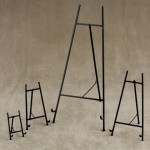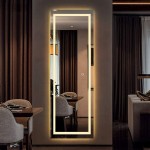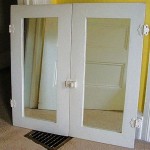Reverse Painted Mirror
Reverse painted glass, also known as verre églomisé, is a decorative technique where an image is painted on the back surface of a piece of glass or mirror. The result is a smooth, glossy surface where the painting appears to float ethereally within the glass itself. This method differs significantly from traditional painting on canvas or directly onto glass. Because the artist works backward, starting with the details and layering toward the background, the process requires careful planning and execution.
Key Points about Reverse Painting Technique
- Painting is applied to the reverse side of the glass.
- Artists work from detail to background layers.
- Requires meticulous planning due to the reversed painting process.
Historically, this technique dates back to ancient Rome, where it was employed to embellish decorative items and create stunning visual effects. The term "verre églomisé" is attributed to Jean-Baptiste Glomy, an 18th-century French framer and decorator, who popularized the technique during the Neoclassical period. While Glomy did not invent the process, he significantly contributed to its resurgence and refinement, using it to enhance frames and decorative objects. The technique found continued popularity in the 19th and 20th centuries, often employed for mirrors, furniture panels, and various decorative arts.
Key Points about the History of Reverse Painted Mirrors
- Origins trace back to ancient Rome.
- The term "verre églomisé" references 18th-century French decorator Jean-Baptiste Glomy.
- Glomy popularized the technique in the Neoclassical period.
- Utilized for decorating frames, mirrors, and furniture.
The process of reverse painting on glass requires specialized skills and materials. The artist typically begins by preparing the glass surface, ensuring it is clean and free of any imperfections. Then, a design or pattern is traced onto the glass, acting as a guide for the painting process. Oil-based paints, metallic paints, and varnishes are commonly utilized due to their adhesion and vibrancy. The paint layers are meticulously applied, starting with the fine details, such as facial features or intricate floral patterns, and gradually building up the background elements. This layered approach is crucial, as subsequent layers can obscure previously applied details.
Key Points on the Creation Process
- Glass surface requires thorough cleaning and preparation.
- A traced design guides the painting process.
- Oil-based paints, metallic paints, and varnishes are typically used.
- Painting progresses from detailed elements to the background.
Reverse painted mirrors offer unique aesthetic qualities. The glass surface provides a smooth, protective layer over the artwork, enhancing its color saturation and luminosity. The reversed application creates an illusion of depth, making the images appear to float within the mirror. This adds a touch of elegance and sophistication to the artwork, often used to depict intricate scenes, floral motifs, or decorative patterns.
Key Points on Aesthetics of Reverse Painted Mirrors
- Glass enhances color saturation and luminosity of the artwork.
- Creates an illusion of depth and a floating effect.
- Often features intricate scenes, floral motifs, or decorative patterns.
Identifying antique reverse painted mirrors requires careful examination. Authentic antique pieces will often exhibit signs of age, such as slight imperfections in the glass or crazing in the paint. The backs of antique mirrors may also reveal evidence of the original silvering techniques, which can differ from modern methods. Examining the style of the artwork and the frame can also offer clues to its age and origin. Consulting with an expert in antique glass or decorative arts can provide further authentication and appraisal.
Key Points on Identifying Antique Reverse Painted Mirrors
- Look for age-related imperfections in the glass or paint.
- Examine the back for signs of original silvering techniques.
- Consider the style of the artwork and the frame.
- Consult with an expert for authentication and appraisal.
Caring for reverse painted mirrors involves gentle handling and cleaning. Avoid using harsh chemicals or abrasive cleaners, as these can damage the delicate paint layers. A soft, damp cloth is generally sufficient for cleaning the glass surface. Protecting the mirror from excessive moisture and extreme temperatures is also important to prevent damage to the artwork or the silvering on the back. For valuable or antique pieces, consulting a professional conservator is recommended for advice on proper care and restoration.
Key Points on Caring for Reverse Painted Mirrors
- Avoid harsh chemicals and abrasive cleaners.
- Clean with a soft, damp cloth.
- Protect from excessive moisture and extreme temperatures.
- Consult a professional for valuable or antique pieces.
Reverse painting on glass remains a vibrant art form, adapted and reinterpreted by contemporary artists. While traditional techniques are still practiced, modern artists also experiment with new materials and methods, incorporating various mediums and styles. The versatility of this technique allows for a wide range of artistic expression, from traditional decorative motifs to contemporary abstract designs.
Key Points on Contemporary Applications
- Traditional techniques are still practiced and valued.
- Modern artists experiment with new materials and methods.
- Allows for versatile artistic expression, from traditional to contemporary styles.

5 Minutes With A Pair Of Chinese Export Reverse Mirror Paintings Christie S

Antique Victorian Etched Reverse Painted Floral Picture On Beveled Wall Mirror

Reverse Painted Glass Wall Mirror With Floral Leaf Motifs Dawn Novica

Gold Framed Reverse Painted Mirror For At 1stdibs

Handcrafted Andean Reverse Painted Glass Wall Mirror Garden Gold Novica

Reverse Painted Glass Mirror W Sea Life Theme 16 X 13 Hand In Peru

Reverse Painted Mirror Trade Aid

Reverse Painted Glass Wall Mirror Idyllic Emerald Garden Hand Mirrors

Mirror Reverse Painted Glass In Black Moroccan Decor R Furniture By Olinda Romani Lance Reynolds

Hand Crafted Reverse Painted Glass Wood Rectangular Wall Mirror Decor Fall Peruvian Ornate Large Mirrors Vanity Norway








